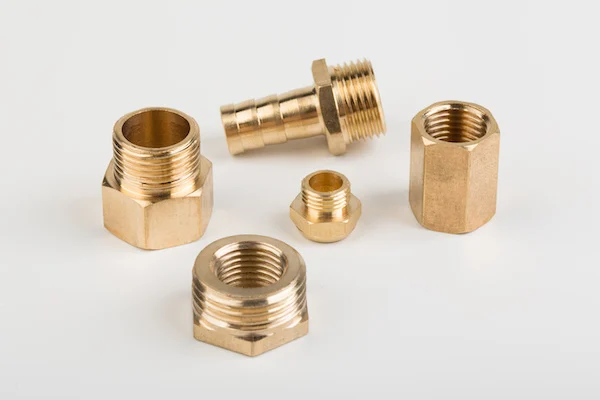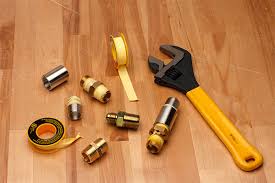Propane fittings typically have tapered threads for high-pressure applications, providing a secure seal, while flat threads are used in low-pressure situations and require additional sealing methods.
Understanding the types of threads used in propane fittings is essential for ensuring the safety and efficiency of propane systems.
This comprehensive article will explore whether the threads on propane fittings are tapered or flat, discuss the significance of each thread type, and provide guidance on selecting the right fittings for your specific needs.
Understanding Propane Fittings:
What Are Propane Fittings?

Propane fittings are specialized components designed to connect propane tanks to appliances, hoses, and other equipment in propane systems. These fittings are critical for creating secure and leak-free connections, which are essential for the safe use of propane as a fuel. Propane is widely used in residential and commercial applications, including heating, cooking, and powering vehicles.
Importance of Thread Types:
The type of thread used on propane fittings plays a significant role in the overall performance of the system. Choosing the right thread type helps prevent gas leaks, which can pose serious safety hazards. Understanding whether your fittings are tapered or flat can significantly impact the efficiency and safety of your propane system.
Types of Threads in Propane Fittings:
Tapered Threads:
Tapered threads are designed to create a seal as they are tightened. The conical shape of tapered threads allows them to compress against the receiving surface, enhancing their sealing capability.
Characteristics of Tapered Threads:
- Design: Tapered threads feature a conical shape, gradually decreasing in diameter towards the end of the fitting. This design allows for a tighter fit as the fitting is screwed in, providing better sealing performance.
- Sealing Mechanism: The sealing occurs as the tapered threads tighten against the receiving end, creating a compression seal that minimizes the chance of leaks. The design helps prevent any gas from escaping, making it ideal for high-pressure applications.
- Common Uses: Tapered threads are predominantly used in high-pressure applications, such as those found in propane systems, making them a reliable choice for secure connections. They are often found in various types of propane fittings, including those used in gas grills, heating systems, and RVs.
Benefits of Tapered Threads:
- Secure Seal: The tapered design creates a more effective seal, which is essential for preventing leaks in propane systems. A tight fit reduces the risk of gas escaping, ensuring safety.
- Ease of Installation: Tapered threads are generally easier to install, as they engage more readily when tightened. This feature can make maintenance and repairs simpler and more efficient.
- Reliability: Tapered threads are well-suited for high-pressure applications, providing the necessary strength and sealing capability for propane connections. This reliability is crucial for ensuring the safe operation of propane-powered appliances.
Flat Threads:

Flat threads, also known as parallel threads, have a consistent diameter throughout their length. Unlike tapered threads, flat threads do not form a seal through compression alone.
Characteristics of Flat Threads:
- Design: Flat threads maintain the same diameter from start to finish, providing a uniform connection point. This design allows for flexibility in various applications, making them versatile fittings.
- Sealing Mechanism: Flat-threaded fittings require an additional sealing method, such as a washer or O-ring, to prevent leaks. This means that the seal is not created by the threads themselves but through other means, which can include adhesive sealants.
- Common Uses: Flat threads are commonly used in lower-pressure applications, such as garden hoses and some pneumatic fittings. They are also found in non-propane systems, such as water and air connections.
Benefits of Flat Threads:
- Versatility: Flat threads can be used in various applications beyond propane, including water and air connections, making them versatile. Their adaptability allows for more options in different types of systems.
- Simpler Design: The uniform design may make flat-threaded fittings easier to manufacture and potentially more cost-effective than tapered fittings. This simplification can lead to lower overall costs for specific applications.
- Custom Sealing Options: Users can select different sealing methods for flat threads, allowing for flexibility depending on their specific application needs. This customizability can help address unique challenges in various systems.
Application Examples:
- Tapered Threads: Used in high-pressure fittings for propane tanks, gas grills, and propane-powered appliances. For example, a tapered fitting connects a propane tank to a BBQ grill, ensuring a safe and reliable gas supply.
- Flat Threads: Often found in low-pressure applications such as hose connections for garden watering systems or air compressors. For instance, a flat-threaded fitting might be used to connect a water hose to a garden faucet.
Safety Considerations:

Importance of Proper Fitting:
Using the correct type of fitting is critical for preventing dangerous leaks. A leak in a propane system can lead to severe hazards, including fire or explosion risks. It’s essential to use the appropriate thread type and fittings to maintain safety standards and comply with regulations.
Regular Maintenance Checks:
Regular inspections and maintenance of your propane fittings are essential to ensure their effectiveness. Here are some tips for maintaining your fittings:
- Inspect for Wear: Check fittings for signs of wear, such as rust, corrosion, or cracking. Replace any damaged fittings immediately to prevent leaks.
- Tighten Connections: Periodically check and tighten connections to ensure they remain secure. However, be cautious not to over-tighten, which can cause damage to the threads and fittings.
- Look for Leaks: Perform a leak test by applying soapy water to the fittings. If bubbles form, there is a leak that needs to be addressed. This simple test can help catch issues early and prevent dangerous situations.
Recognizing Signs of Trouble:
Being aware of the signs that indicate problems with propane fittings can be crucial for safety:
- Unusual Smells: Propane has a distinct odor, often described as similar to rotten eggs. If you notice this smell, it may indicate a leak.
- Hissing Sounds: A hissing sound near propane connections can also signify a leak, warranting immediate attention.
- Physical Damage: Inspect fittings regularly for physical damage or signs of wear that could compromise their integrity.
Choosing the Right Propane Fittings:
Assessing Your Needs:
When selecting propane fittings, consider the following factors to ensure you choose the right options for your system:
- Pressure Requirements: Determine whether your application requires high-pressure fittings (typically tapered) or low-pressure fittings (often flat). This assessment is crucial for safety and functionality.
- Compatibility: Ensure that the fittings are compatible with your existing equipment and appliances. Mismatched fittings can lead to leaks and other issues.
- Sealing Needs: Evaluate whether you need tapered or flat threads based on the sealing method required for your system. Understanding the specific needs of your application will help guide your choices.
Tips for Selection:
- Consult Professionals: When in doubt about your choices, consult with propane experts or professionals. They can provide valuable insights into the best fittings for your specific application and help you avoid common pitfalls.
- Follow Manufacturer Guidelines: Always refer to the manufacturer’s guidelines for your propane appliances and fittings. These guidelines offer essential information about compatible fittings and installation practices, ensuring you make informed decisions.
- Use Quality Products: Invest in high-quality fittings from reputable manufacturers. Quality fittings are more likely to provide reliable performance and safety. Cheaper alternatives may not meet safety standards, leading to potential hazards.
FAQ’s
1. Are propane fittings usually tapered or flat?
Propane fittings are primarily tapered to create a secure seal in high-pressure applications.
2. What is the purpose of tapered threads in propane fittings?
Tapered threads create a compression seal, minimizing the risk of gas leaks and ensuring safety.
3. Can flat-threaded fittings be used for propane?
Yes, flat-threaded fittings can be used, but they require additional sealing methods like washers to prevent leaks.
4. How can I check for leaks in propane fittings?
You can perform a leak test by applying soapy water to the fittings; bubbles indicate a leak.
5. What should I consider when choosing propane fittings?
Consider the pressure requirements, compatibility with existing equipment, and the sealing method needed for your system.
Conclusion
In summary, propane fittings usually have tapered threads for high-pressure applications, while flat threads need extra sealing for low-pressure situations. Selecting the right thread type is essential for safety and leak prevention. Regular maintenance is crucial for efficient propane system operation.